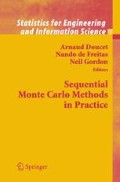Abstract
The posterior filter density of most nonlinear recursive estimation problems cannot be described analytically by a finite number of parameters. Several examples of sub-optimal algorithms for practical sequential estimation have therefore appeared in the literature. Generally, these procedures approximate either the estimation model or the description of the posterior distribution. These inevitable approximations may seriously degrade the estimation performance when compared with the results that would have been obtained had Bayesian inference, based on the true posterior density, been carried out. It is of great practical interest to quantify this performance degradation, and measure the effect of the introduced approximations. A benchmark simulation evaluation against the optimal solution is not possible because it would require infinite computing power and unlimited memory to run the optimal algorithm However, even if it is intractable to implement and run the optimal solution a lower bound on the performance of this solution can be obtained. The estimation error obtained with an optimal algorithm depends only on the fundamental properties of the model, e.g. signal-to-noise levels and prior assumptions on the sought parameters. Characteristics of the estimation error from the optimal solution define lower limits on the performance that can be achieved using any practical implementation. The characteristics of the sub-optimal estimation error achieved by an approximate implementation are revealed in simulations using the implemented procedure. The discrepancy from the lower bound gives an indication of the effect of the approximations introduced in the implemented algorithm. A relative comparison between the sub-optimal and the optimal algorithms is therefore possible even if it is intractable to implement the optimal solution. A lower bound on some property of the estimation error is convenient for evaluation purposes, but can also be used to shed light on the fundamental performance level that can be reached for the estimation problem.
Access this chapter
Tax calculation will be finalised at checkout
Purchases are for personal use only
Preview
Unable to display preview. Download preview PDF.
Editor information
Editors and Affiliations
Rights and permissions
Copyright information
© 2001 Springer Science+Business Media New York
About this chapter
Cite this chapter
Bergman, N. (2001). Posterior Cramér-Rao Bounds for Sequential Estimation. In: Doucet, A., de Freitas, N., Gordon, N. (eds) Sequential Monte Carlo Methods in Practice. Statistics for Engineering and Information Science. Springer, New York, NY. https://doi.org/10.1007/978-1-4757-3437-9_15
Download citation
DOI: https://doi.org/10.1007/978-1-4757-3437-9_15
Publisher Name: Springer, New York, NY
Print ISBN: 978-1-4419-2887-0
Online ISBN: 978-1-4757-3437-9
eBook Packages: Springer Book Archive

